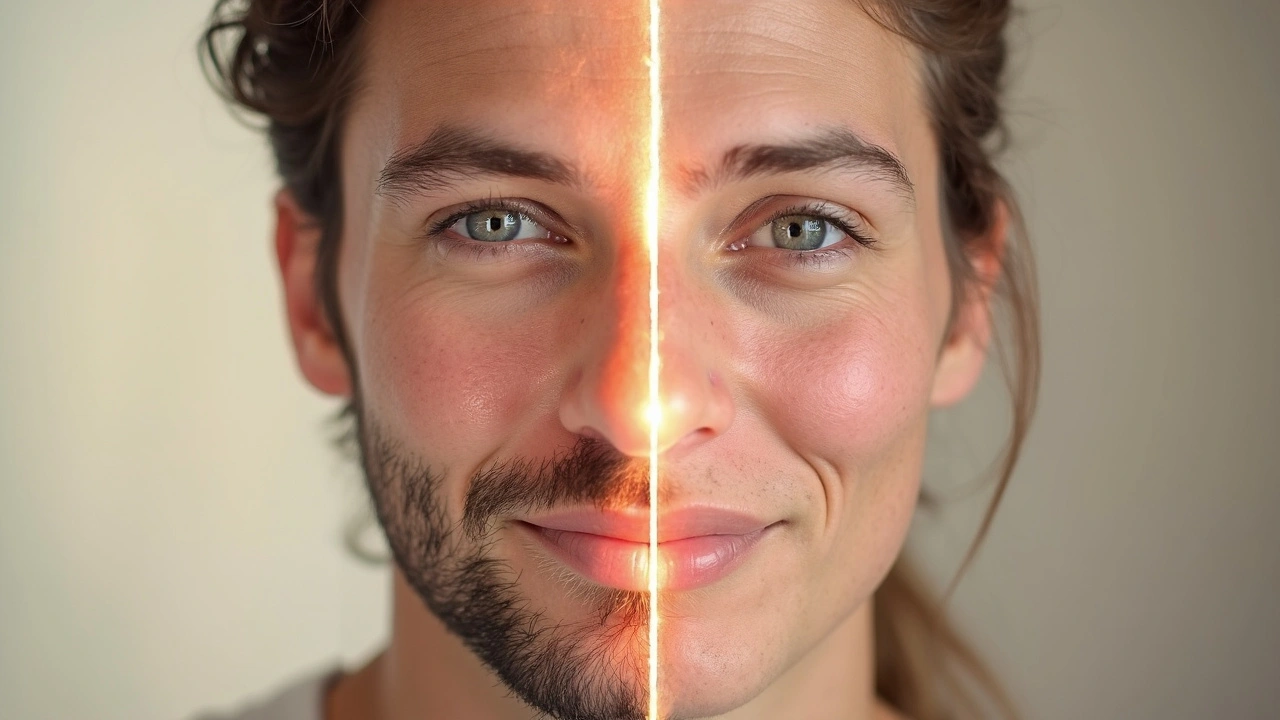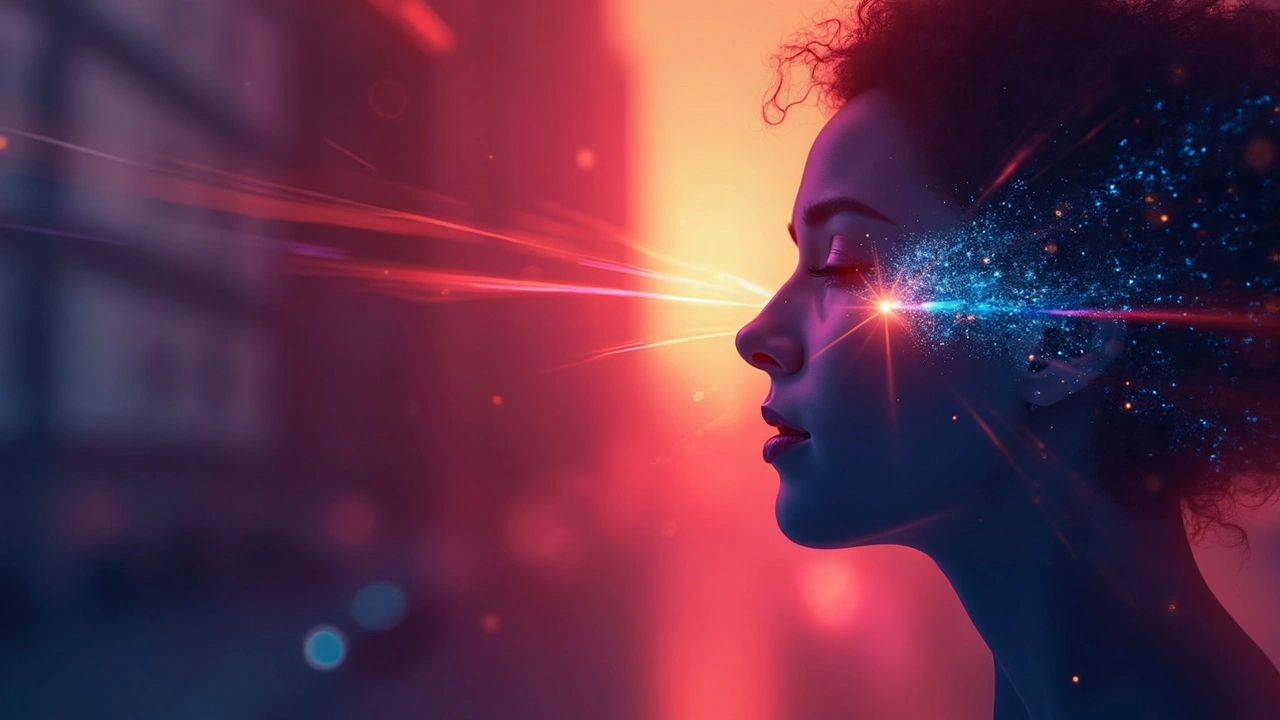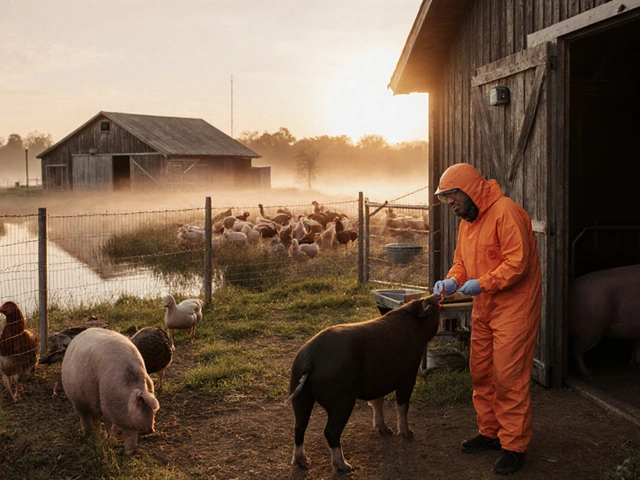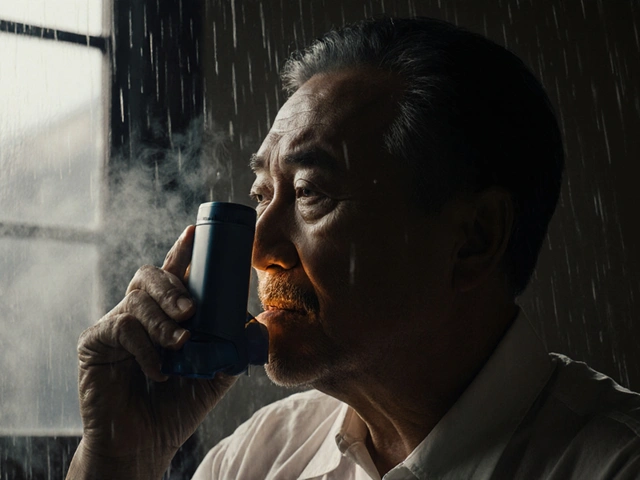Rosacea can be maddening, especially when that leftover sunburn-like redness just lingers no matter what you try. You moisturize, avoid the obvious triggers, and slather on SPF, but your cheeks still have that permanent pink flush. Maybe you're constantly fielding questions—"Did you catch the sun?" or "Are you feeling warm?"—when really, it's just your skin acting up again. What if I told you there's a high-tech fix that's becoming the go-to in top skin clinics all over the UK? Laser and light treatments for rosacea redness are getting serious attention. But what actually sets V-beam and IPL apart, and does the redness ever come back? Let’s untangle the best-kept secrets and real talk about these solutions.
Why Persistent Rosacea Redness Happens
Most people think of rosacea as your classic red nose or cheeks that flame up after a glass of wine or a day out in the wind. But persistent redness—the kind that looks like an everlasting sunburn—feels especially tough to manage. Under the surface, tiny blood vessels called capillaries break or dilate way too easily. Stress, spicy food, or just a brisk morning walk can leave your face glowing when you least want it. Dermatologists call this erythema, and it’s stubborn. Standard creams or prescriptions target breakouts or bumps, but nothing ever seems to really dial down that everyday flush.
According to recent research from the British Association of Dermatologists, more than half of rosacea patients report that visible redness is the symptom that bothers them most—not the occasional spot, but that ever-present pinkness. Why? It’s visible. It doesn’t fade. Makeup only partly masks it, and sometimes makeup itself makes it worse. The urge to cover up can leave you avoiding photos and feeling like you need to explain your face. For a lot of us, that’s harder than dealing with the odd breakout.
A big part of why this redness sticks around is structural. When blood vessels get fragile or multiply near the skin surface, their walls let little bits of blood leak out or make the skin look flushed. While sun damage is a player, there’s also plain bad luck and genetics. If a parent or grandparent had rosy cheeks, chances are you’ll see those popping up, too. In the UK, the fairer the skin, the higher the risk. Did you know that as many as one in ten people in northern Europe show signs of chronic redness? That’s a lot of us hiding behind scarves and hats on sunny days. But here’s the twist—you don’t have to live with it forever.
V-Beam Laser: How It Works and What to Expect
The V-beam laser is something of a game-changer for stubborn rosacea redness. It’s nicknamed the "vascular laser" because it targets blood vessels and nothing else. The tech uses a pulsed dye laser at a specific wavelength (595 nm, if you’re into numbers), meaning it fires short bursts of light that get soaked up by the red pigment in your blood. When those flashes hit the vessel, the heat causes it to collapse, fade, or get absorbed by your body’s own cleanup crew. In short: less redness, less visible capillaries, and a calmer face.
Treatment is fast. A typical session lasts 15–30 minutes, depending on how big the area is. Most people do a course of three to five treatments, spaced about four weeks apart. The sensation? It’s often described as a teeny flick from a rubber band—not agony, but enough to know it’s working. Clinics usually use cooling systems (think blasts of cold air) to help your skin chill out before, during, and after the zap. This makes a surprising difference in comfort and prevents bruising.
Here’s a fun fact: the V-beam got its name from the visible purple dye in the laser’s handpiece (so, nothing to do with electricity or beams in sci-fi films). It’s designed especially for redness, broken veins, and even kids with port wine stains. Dermatologists in major UK cities swear by it for rosacea because it’s selective—it leaves surrounding skin alone, so you’re not risking burns or texture changes.
Downtime with V-beam is pretty minimal. The day after, you might look a bit flushed or blotchy, almost like you’ve had a brisk walk in the park. Some people get tiny, faint bruises called "purpura" that fade in a few days. Most are back to work and just throw on a bit of concealer. Rarely, there’s swelling (especially around the eyes), but this is short-lived. UK guidelines usually say to avoid gyms and hot baths for 48 hours, but otherwise you can function totally normally.
How long do results last? Many see a big reduction after the first set of treatments, but if your triggers (alcohol, sun exposure, spicy foods) come back, redness can sneak up again in six to twelve months. That said, annual maintenance zaps often keep things under control. People with rosacea redness especially love this option, since they finally get a break from comments about their skin.

IPL (Intense Pulsed Light): Versatility and Benefits
IPL therapy is a little different from a laser, but the gist is similar: it uses light energy to break down visible redness. Instead of focusing on one wavelength like the V-beam, IPL is broad-spectrum. Imagine a camera flash—IPL uses quick pulses of high-intensity visible light that scatter into the deep layers of the skin. This is good news if you’ve got not only redness but also pigmentation, sun spots, or those rough bumpy patches rosacea loves to bring. Many top clinics in London and across the UK use IPL as a multitasker—it handles several concerns in one visit.
The experience is a lot like V-beam: sessions last 20–30 minutes, with multiple rounds spaced three to four weeks apart. Some clinics offer what they call a "Photofacial"—a fancy name for IPL targeting redness and dark spots. You’ll wear protective goggles, feel a warm snap or prickling sensation, and possibly notice a mild sunburn-peel in the days after. Immediately post-treatment, skin feels tighter and brighter—a nice bonus if you’re chasing that glow as well as less redness.
One cool perk: IPL is especially flexible in treating larger areas, like the whole face, neck, or even chest. That’s great if your redness spreads beyond just your cheeks. Also, because the light penetrates deep, it indirectly stimulates collagen, helping skin look fresher as the broken vessels fade. IPL is safe for a range of skin types, although the fairest complexions tend to see the most dramatic changes. If you’re someone who tans easily or has darker skin, though, you’ll want a specialist who knows how to avoid pigmentation issues. Always worth checking a clinic’s before-and-after photos—that’s where you’ll spot true expertise.
With IPL, downtime is usually mild. Yes, some redness and swelling is normal for a day or two, but nothing wild. If you’re sensitive, occasional mild bruising can show up. Sun protection is non-negotiable for at least a week—otherwise, there’s a risk of pigment changes or patchiness. Pro tip: Keep your fridge stocked with soothing gel masks or pop your usual moisturizer in the chiller for an extra blast of coolness after your session.
Results tend to build over multiple visits. Some see dramatic shifts in three sessions, others need five or six. You’ll likely notice redness is less "angry" after each round. To keep things looking clear long-term, expect touch-ups every six to twelve months. Think of it as skincare maintenance—like booking your hairdresser or dentist but for your face. Don’t be shy about asking for package deals; many clinics shave money off the price if you commit upfront.
Choosing Between V-Beam and IPL: Facts and Myths
So, which is better for that stubborn, sunburn-like rosacea redness? The truth is, each has serious pros—and it depends on your skin, lifestyle, and budget. For classic, fiery redness and those visible little ‘road map’ veins, V-beam often comes out on top. Studies from University College London hospitals found it wiped out visible vessels more quickly and with less risk of rebound than IPL, making it many dermatologists’ first choice.
But don’t overlook IPL if your rosacea comes with freckles, blotches, and texture. Since it treats both vessels and pigment, it’s a smart two-in-one. Many people actually combine both treatments: V-beam for targeted “zapping” and IPL for a sweeping glow-up. Some clinics even offer these back-to-back, but always check how your skin reacts before doubling up.
There’s a persistent myth that these treatments are only temporary or that the redness always returns. While it’s true that genetics and lifestyle bring rosacea roaring back, people who care for their skin and stick with annual top-ups find results last far longer than any cream could offer. It’s all about realistic expectations—these lasers and lights turn down the dial, but you still need daily SPF, gentle skincare, and smart avoidance of your worst triggers (that glass of Shiraz or surprise heatwave, for example). You can find even more advice and practical guides for your own skin at trusted sources like this rosacea redness treatment article, where real-world flare-up management gets explained.
One thing that sets successful patients apart? Consistency. If you’re thinking one session will erase years of redness, you might feel underwhelmed. But regular, spaced treatments—especially in the first six months—give your blood vessels a much-needed reset. Don’t skip patch tests, and always ask about your practitioner’s experience. In the UK, laser clinics are regulated, but experience matters just as much. Read reviews, stalk their Instagram portfolios, and never be afraid to ask questions.

Recovery, Downtime, and Daily Life After Laser or IPL
Alright, so you’re booked in for your first session and starting to worry—Will I need a week hiding under a duvet? In reality, recovery after V-beam or IPL is surprisingly gentle. Most people see mild redness, swelling, or faint bruising right after, but nothing that would make you avoid work or a quick stop at Tesco. If you have sensitive skin, you might feel a little raw for the first 48 hours—sort of like windburn. Cold packs, fragrance-free moisturizers, and staying off the hot tea help a lot.
One tip derms swear by: avoid touching or scrubbing your face in the days after. Your skin is working overtime to heal and settle new vessels. Swap your normal routine for gentle, ultra-hydrating cleansers, skip any exfoliants or acids (even the gentle ones), and forget about retinoids for at least a week. Sun protection is a golden rule—SKIN that’s just been "zapped" is extra needy and sensitive to UV rays. Most city dwellers in Bristol notice their faces feel a little dry the day after, so don’t panic if your makeup goes patchy. It’s part of the process.
Most folks can go back to work the next day. After V-beam, especially, light bruises (think faint purple dots) may pop up if your specialist goes for deeper vessels—these fade in a few days or can be lightly covered with non-comedogenic concealer. With IPL, slight peeling or dryness might be a sign that the light pulses are doing their bit under your skin. Keep up a routine of hydration, SPF, and a little downtime from sweaty activities like spin class or sauna sessions for at least 48 hours.
Once the redness subsides, you’ll notice not only less flushing but a smoother skin texture overall. Many say their makeup applies more evenly, their skin feels less irritable, and the daily stress about unwanted comments drops away. There’s something freeing about walking through Bristol’s harbourside without worrying about your face matching your jacket. It’s not perfection—but it’s progress you can see in the mirror and your selfie camera.
Long-term, keep in mind flareups might still happen if you hit a personal trigger (hello, spicy curry or cold weather), but they recover faster, and your baseline redness is far less "sunburned" than before. For lasting results, combine the treatments with a routine like gentle cleansers, barrier-boosting creams, and regular SPF50. Check-ins with your practitioner every six to twelve months help catch new problem spots early.
So, if you’ve been feeling stuck with that tomato-faced flush and nothing in your medicine cabinet gives relief, lasers and IPL could be a breakthrough. With the right care, results can last and get even better—a new normal for your mirror, one that's a lot less red and a lot more confident.




Ismaeel Ishaaq
July 17, 2025 AT 23:21Wow, this post really hits the nail on the head for anyone struggling with stubborn rosacea redness! I've seen so many people just lose confidence because of their inflamed skin, and the fact that treatments like V-beam and IPL can offer real relief with minimal downtime is pretty thrilling.
What really catches my attention is how this article distinguishes between these two treatment types. It's like a revelation; not just a one-size-fits-all approach but guiding us on who should opt for which treatment. That's crucial, considering how personal skin issues are.
But here’s my aggressive take: why is it still so common to suffer from rosacea without exploring these options? Awareness is king, folks. If you have options that can calm your skin quicker and with fewer disruptions to daily life, why hesitate?
Also, I love the mention of what life is like after the redness fades. It’s not just about the procedure; it’s about the transformation. The confidence boost from clearer skin? Priceless. Anyone else here tried these treatments and want to share your colorful experiences?
Jesse Goodman
July 18, 2025 AT 18:45Seriously, this stuff is impressive. Laser treatments that zap away redness? Sounds too good to be true, but the minimal downtime makes it even better. Can't imagine dealing with rosacea and its persistent red hues without such options.
It's kind of like peeling back the layers of confusion many people have about skin treatments. I mean, IPL and V-beam might sound technical, but this post makes it all so approachable.
Also, gotta admit, this reminded me that seeing clear skin isn’t just physical; it’s mental peace. Something we all chase, right? 😊
Antara Kumar
July 19, 2025 AT 14:06Honestly, I’m skeptical about the whole laser hype. Sure, they claim minimal downtime and impressive results, but who really benefits here? Are these treatments just an expensive fix for a problem that might be better handled with lifestyle changes?
It seems like people are jumping on the bandwagon without questioning if these medical treatments are really necessary or just another cosmetic fad. Sunburn-like redness? Maybe it's a sign to rethink sun protection or diet rather than zap lasers on your face.
Still, I’m curious if anyone here has had long-term success or if the redness eventually just sneaks back. These posts often leave out the catch.
John Barton
July 20, 2025 AT 09:30Ah yes, the magical lasers that promise to erase all reminders of your sunburn-faced existence overnight. Spoiler alert: it’s not some sci-fi miracle; it’s a medical procedure with its quirks and quirks.
People need to stop romanticizing these treatments like they’re the Holy Grail of skincare. Sure, V-beam and IPL help, but does anyone stop to think about the creepy crawl of side effects or the patience needed for actual healing?
Minimal downtime is a joke if your skin flakes or peels for weeks and you’re stuck avoiding the sun like a vampire. But hey, who’s really complaining when you get bragging rights for your “calmer, clearer skin”?
Achint Patel
July 21, 2025 AT 04:52To weigh in a bit more analytically, the distinction between V-beam and IPL is fundamental given their mode of action on vascular lesions. While both aim at reducing erythema, V-beam's pulsed dye laser targets blood vessels more precisely, usually resulting in fewer sessions.
IPL, on the other hand, casts a broader light spectrum and might be better suited for patients with mixed pigmentation issues alongside redness.
It’s essential for patients to consult dermatologists to tailor treatment plans rather than blindly opt for what sounds most fashionable or affordable. The post rightly underscores the importance of understanding downtime, which varies depending on individual skin sensitivity.
Lilly Merrill
July 22, 2025 AT 00:15This subject is so important, especially as more people seek solutions that don’t disrupt their daily routines. I appreciate how the post clarifies that minimal downtime doesn’t mean no downtime—setting realistic expectations is key.
What I find helpful is having tips for post-treatment care—sunscreen use, gentle skincare products, and avoiding triggers. It really rounds out the advice for someone considering these treatments.
It's comforting to see a balanced take that doesn't overpromise but encourages confident steps toward clearer skin, which is what many people need.
Charlie Martin
July 22, 2025 AT 19:38Jumping in here, I wonder about the accessibility of V-beam and IPL treatments. Are they widely available or largely limited to upscale clinics? Also, for people who might want to try these, what about the cost factor? Not everyone can drop big bucks on laser sessions.
It’s a bit of a gatekeeper if these options aren’t feasible for most people suffering from rosacea. It’d be great to hear some insights or alternatives that balance efficacy and affordability.
Danielle Watson
July 23, 2025 AT 15:01I’m really interested in hearing about how people’s skin feels immediately after these treatments. I know the post says minimal downtime, but did you experience any discomfort, tightness, or sensitivity? Also, how long before the redness actually starts to fade?
Sometimes the reality differs from the clinical descriptions, so it’s helpful to get real-life perspectives. It's a journey, right? Not just a one-time fix.
Kimberly :)
July 24, 2025 AT 10:25Well, I can’t help but find it a bit ironic how everyone is raving about lasers while forgetting about the importance of daily skin discipline. Like, seriously, you gotta maintain a routine with good hydration, sun protection, and maybe cooling gels if rosacea tends to flare.
Yes, lasers can help, but they’re not a replacement for responsible skincare. That said, I’m curious if the treatments have any long term effects on skin texture or pigmentation? Anyone here notice changes beyond just less redness? 😊
Sebastian Miles
July 25, 2025 AT 05:48From a dermatological standpoint, both V-beam and IPL belong in a comprehensive rosacea treatment plan that may include topical medications and lifestyle modifications. It’s never purely cosmetic intervention but a multi-pronged strategy.
The jargon gets dense when discussing laser wavelengths and pulse durations, but patient education is critical. This post does well to demystify these aspects while emphasizing what outcomes patients can realistically expect, especially regarding downtime.
Supportive coaching during recovery is often neglected, so kudos for highlighting life post-treatment, which really seals the deal for confidence.
Harshal Sanghavi
July 26, 2025 AT 01:11Hey, just throwing it out there, anyone else feel like this whole laser thing is oversold sometimes? Like sure, it works, but have you checked if the redness comes back or if you need continuous treatments? It’s a bit like those shows that promise a makeover but neglect the aftercare drama.
That said, when handled properly and with realistic expectations, these treatments definitely lift spirits. I don’t mind the downtime if the results keep me from having to wear makeup every day to cover up. Worth thinking about.